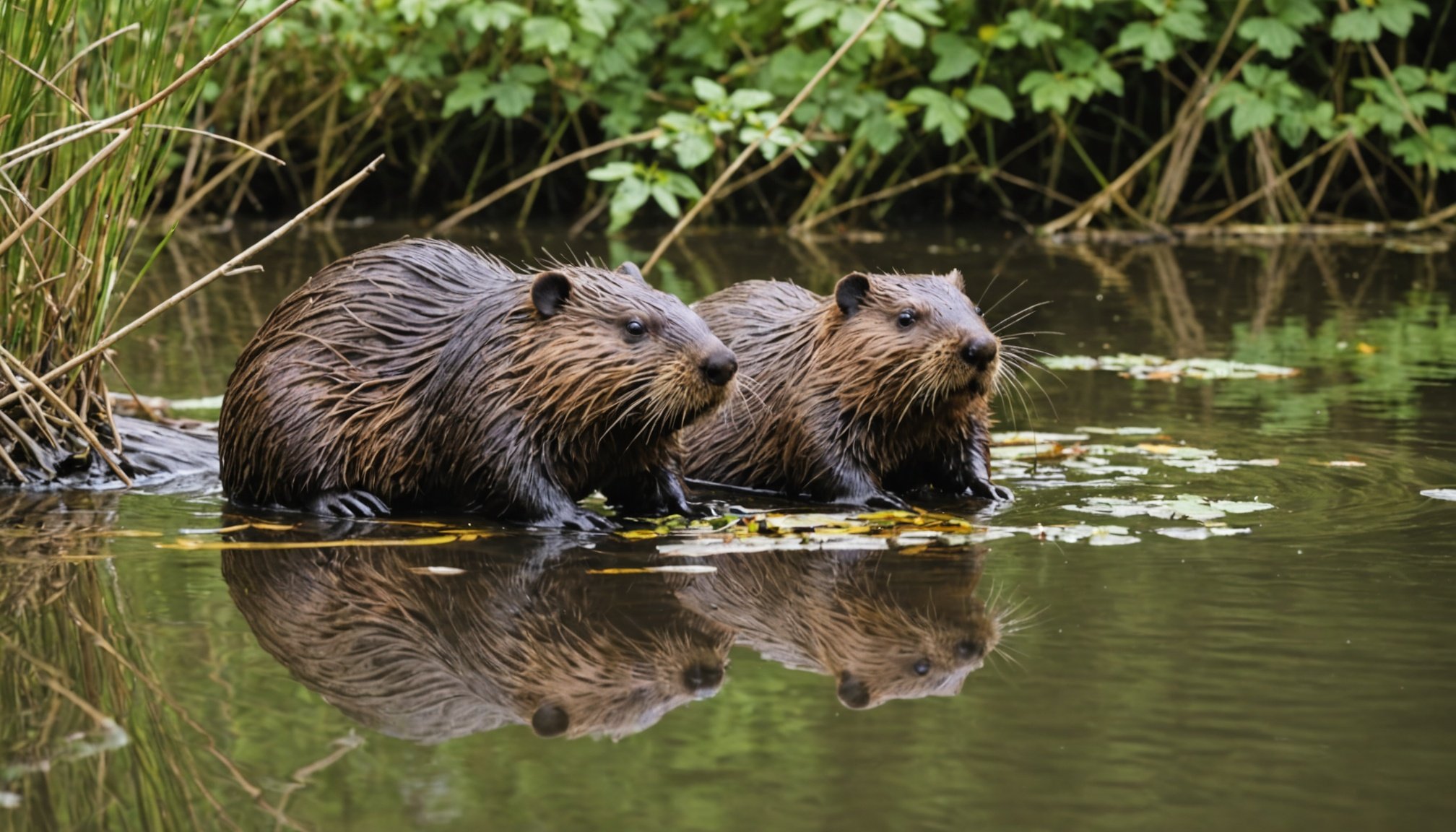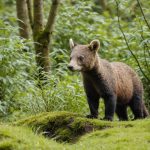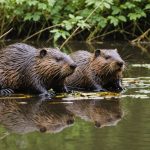The Impact of Beaver Reintroduction on UK River Ecosystems: A Deep Dive into Nature’s Engineers
The Return of the Beavers: A Historical and Ecological Context
The reintroduction of beavers to UK rivers marks a significant milestone in the country’s conservation efforts. For centuries, beavers, specifically the Eurasian beaver (Castor fiber), were absent from the UK’s waterways, having been hunted to local extinction. However, recent initiatives have brought these ecosystem engineers back, and their impact is nothing short of remarkable.
“In recent times, the reintroduction of these beavers is creating exciting opportunities for the restoration of natural freshwater habitats,” notes Dr. Dan Osmond, Senior Fisheries Scientist at the Westcountry Rivers Trust[3].
Lire également : Exploring Habitat Management Strategies by UK Wildlife Trusts to Support Diverse Species
Ecological Benefits: How Beavers Shape Their Environments
Beavers are renowned for their dam-building activities, which have far-reaching ecological benefits. Here are some key ways in which beavers influence their environments:
- Habitat Creation: Beaver dams create unique wetland habitats that support a diverse range of wildlife. These wetlands act as natural filters, improving water quality by allowing sediments to settle and trapping pollutants[4].
- Flood Mitigation: By slowing down water flow, beaver dams help reduce the risk of sudden, damaging floods downstream, protecting both wildlife and human communities. The Devon Beaver Trial, for example, documented a 37% reduction in peak river flow during heavy rainfall[4].
- Biodiversity Increase: The introduction of beavers has been shown to increase the diversity and abundance of wildlife. The Devon Beaver Trial observed a 50% increase in the number of species in the area, including rare and threatened species like the water vole and the otter[4].
- Carbon Sequestration: Beaver-created wetlands can also play a role in carbon sequestration. The slower water flow and increased vegetation in these areas help in accumulating carbon in the soil and vegetation.
Case Study: The Devon Beaver Trial
One of the most significant projects highlighting the impact of beaver reintroduction is the Devon Beaver Trial. Launched in 2011 by the Devon Wildlife Trust, this trial was the first licensed beaver reintroduction in England.
A découvrir également : Exploring the UK”s Strategies for Monitoring and Combating Wildlife Disease Spread from Pets to Wild Animals
Key Findings
- Reduced Flood Risk: The trial showed a significant reduction in peak river flow, reducing the risk of flooding.
- Improved Biodiversity: There was a notable increase in the number of species observed in the area.
- Enhanced Water Quality: The beaver dams helped in improving water quality by filtering out sediments and pollutants.
- Community Engagement: The trial involved extensive collaboration with local communities, farmers, and landowners to address any potential conflicts or concerns.
“The findings of this project were significantly positive. They highlighted the multitude of ways in which beavers contribute to the health and resilience of ecosystems,” explains a report from the University of Exeter[4].
Challenges and Concerns
While the reintroduction of beavers offers numerous benefits, it also raises several concerns and challenges:
Interaction with Migratory Fish
One of the primary concerns is the interaction between beavers and migratory fish. For instance, the introduction of beavers could potentially alter the habitats of species like the Atlantic salmon, which is already endangered in England and Wales[3].
Land Use and Human Impact
The modification of landscapes over centuries, including the straightening and canalization of rivers, presents challenges for beaver reintroduction. However, beavers can adapt and even help in re-naturalizing these modified environments[3].
Community and Landowner Engagement
Ensuring that local communities and landowners are on board with beaver reintroduction is crucial. This involves addressing concerns about potential damage to crops or property and providing education on the long-term benefits of beaver activity[4].
The Cairngorms Connect Project: A Large-Scale Restoration Effort
In Scotland, the Cairngorms Connect project stands out as one of the most ambitious nature restoration projects in Britain. This project, supported by the Centre for Landscape Regeneration (CLR) at the University of Cambridge, aims to regenerate habitats and species over a 200-year vision.
Key Components
- Habitat Regeneration: The project involves expanding woodlands, repairing blanket bogs, rewilding rivers, and restructuring plantations.
- Species Reintroduction: Beavers and other species, such as wild cats, are being reintroduced to the area.
- Community and Landowner Involvement: The project includes collaboration with local communities and four key landowners: Forestry and Land Scotland, RSPB Scotland, NatureScot, and Wildland Ltd[1].
“For two beaver pairs to have bred successfully proves the work that has gone into identifying suitable habitat and locations has been worthwhile,” said Dr. Roisin Campbell-Palmer, Head of Restoration at the Beaver Trust[1].
Practical Insights and Actionable Advice
For those interested in supporting or implementing beaver reintroduction projects, here are some practical insights and actionable advice:
Monitoring and Research
- Regular monitoring is essential to assess the impacts of beaver activity on the ecosystem. This includes tracking biodiversity patterns, tree growth, and carbon accumulation in the soil[1].
- Collaborative research between scientists, conservationists, and local communities is crucial for understanding the long-term benefits and challenges of beaver reintroduction.
Community Engagement
- Engaging with local communities and landowners is vital. This involves educating them about the benefits of beaver activity and addressing any concerns they may have[4].
Sustainable Management
- Ensuring that beaver reintroduction projects are managed responsibly and sustainably is key. This includes mitigating any risks to migratory fish populations and other species[3].
The reintroduction of beavers to UK rivers is a significant step towards restoring the health and resilience of ecosystems, mitigating the impacts of climate change, and preserving the natural world for future generations.
“By working together, we can better support the landscape to benefit all,” says Professor David Coomes, Co-Director of the Centre for Landscape Regeneration[1].
As we move forward, it is our responsibility to ensure that these projects are managed with care, collaboration, and a deep understanding of the complex interactions within ecosystems. The humble beaver, with its industrious nature and unique dam-building abilities, has a crucial role to play in our efforts to protect and restore our environment.
Detailed Bullet Point List: Ecological Benefits of Beaver Reintroduction
- Habitat Creation:
- Beaver dams create wetland habitats that support a diverse range of wildlife.
- These habitats act as natural filters, improving water quality.
- Flood Mitigation:
- Beaver dams slow down water flow, reducing the risk of sudden, damaging floods.
- This protects both wildlife and human communities.
- Biodiversity Increase:
- The introduction of beavers increases the diversity and abundance of wildlife.
- Rare and threatened species, such as the water vole and the otter, benefit from these habitats.
- Carbon Sequestration:
- Beaver-created wetlands help in accumulating carbon in the soil and vegetation.
- Improved Water Quality:
- The slower water flow allows for more sediment to settle out of the water.
- The wetlands created by the dams trap pollutants, improving the clarity and quality of the water.
- Support for Other Species:
- Beaver dams provide habitat for various other species, including fish, birds, and plants.
- The creation of beaver ponds can lead to an increase in the number of species observed in the area.
Comprehensive Table: Comparison of Beaver Reintroduction Projects
| Project | Location | Key Findings | Challenges | Collaborators |
|---|---|---|---|---|
| Devon Beaver Trial | River Otter, England | Reduced flood risk, improved biodiversity, enhanced water quality | Interaction with migratory fish, community engagement | Devon Wildlife Trust, University of Exeter |
| Cairngorms Connect | Cairngorms National Park, Scotland | Habitat regeneration, species reintroduction, community involvement | Large-scale land use changes, high deer numbers | Centre for Landscape Regeneration, Forestry and Land Scotland, RSPB Scotland, NatureScot, Wildland Ltd |
| Westcountry Rivers Trust | Westcountry, England | Monitoring beaver impact on fish populations, integrating electrofishing data | Potential risks to migratory fish, land use modifications | Westcountry Rivers Trust, Cornwall Wildlife Trust, Centre for Resilience in Environment, Water and Waste (CREWW) |
Quotes from Experts
- “For two beaver pairs to have bred successfully proves the work that has gone into identifying suitable habitat and locations has been worthwhile.” – Dr. Roisin Campbell-Palmer, Head of Restoration at the Beaver Trust[1].
- “By working together, we can better support the landscape to benefit all.” – Professor David Coomes, Co-Director of the Centre for Landscape Regeneration[1].
- “The reintroduction of these beavers is creating exciting opportunities for the restoration of natural freshwater habitats.” – Dr. Dan Osmond, Senior Fisheries Scientist at the Westcountry Rivers Trust[3].











